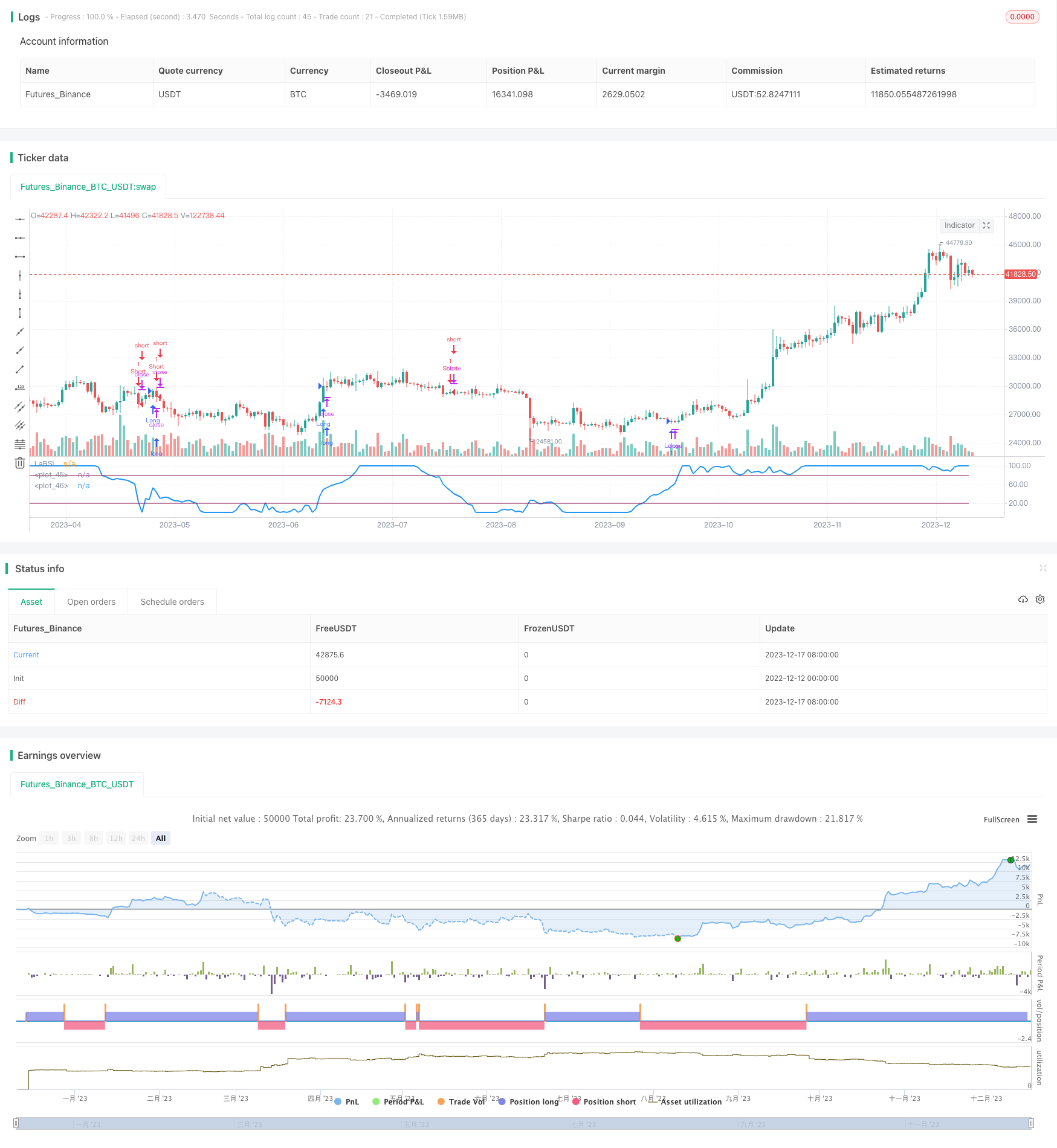
概述
拉盖尔RSI交易策略是基于John EHLERS的拉盖尔滤波器的RSI指标。该策略通过调整α系数来增加或减少RSI指标的滞后性和平滑性,从而过滤掉RSI指标的噪音,发出更清晰的买卖信号。
策略原理
该策略的核心指标是拉盖尔RSI。它的计算公式如下:
L0 = (1-γ)*Src + γ*L0[1]
L1 = -γ*L0 + L0[1] + γ*L1[1]
L2 = -γ*L1 + L1[1] + γ*L2[1]
L3 = -γ*L2 + L2[1] + γ*L3[1]
这里γ=1-α,α是可以调整的系数,Src代表价格。L0到L3是包含递推关系的4个指标。在此基础上可以计算当前上涨积分cu和下跌积分cd:
cu = (L0>L1 ? L0-L1 : 0) + (L1>L2 ? L1-L2 : 0) + (L2>L3 ? L2-L3 : 0) cd = (L0
然后利用cu和cd可以计算出拉盖尔RSI:
LaRSI = cu / (cu + cd)
这里通过递归滤波器的结构,拉盖尔RSI指标在保持RSI指标趋势识别能力的同时,过滤了大量的随机性噪音,能够产生更清晰平滑的交易信号。
具体交易规则: 当拉盖尔RSI指标上穿20时做多;当拉盖尔RSI指标下穿80时做空。
优势分析
拉盖尔RSI策略的主要优势有:
通过拉盖尔滤波器结构有效过滤RSI指标噪音,使得交易信号更清晰可靠
α系数的调整使得策略的参数可以灵活优化,适应更广泛的市场环境
保留了RSI指标的长期有效性,同时通过滤波器实现动量识别,整合趋势和超买超卖
策略规则简单直观,容易实施,在多种市场环境下表现较好
风险分析
该策略主要存在以下风险:
α系数不当设置可能导致过度滞后或过滤过度,错过价格变化
大幅震荡市场中可能出现频繁交易亏损
长期持续牛市可能错过部分上涨机会
优化方向
该策略可以从以下几个方面进行优化:
利用机器学习算法优化α系数的设置
增加止损机制,降低亏损风险
结合其他指标判断过滤误报信号
增加 quantitative easing 模式,在特定阶段锁定盈利
总结
拉盖尔RSI策略通过滤波机制有效识别超买超卖情况,在发出交易信号的同时避免被噪音干扰。该策略简单实用,参数优化空间大,能够适应各种市场环境,是一种值得推荐的交易策略。
/*backtest
start: 2022-12-12 00:00:00
end: 2023-12-18 00:00:00
period: 1d
basePeriod: 1h
exchanges: [{"eid":"Futures_Binance","currency":"BTC_USDT"}]
*/
// This source code is subject to the terms of the Mozilla Public License 2.0 at https://mozilla.org/MPL/2.0/
// © mertriver1
// Developer: John EHLERS
//@version=3
// Author:Kıvanç Özbilgiç
strategy("Laguerre RSI", shorttitle="LaRSI", overlay=false)
src = input(title="Source", defval=close)
alpha = input(title="Alpha", type=float, minval=0, maxval=1, step=0.1, defval=0.2)
colorchange = input(title="Change Color ?", type=bool, defval=false)
Date1 = input(true, title = "=== Date Backtesting ===")
FromDay1 = input(defval = 1, title = "From Day", minval = 1, maxval = 31)
FromMonth1 = input(defval = 1, title = "From Month", minval = 1, maxval = 12)
FromYear1 = input(defval = 2020, title = "From Year", minval = 2017)
ToDay1 = input(defval = 1, title = "To Day", minval = 1, maxval = 31)
ToMonth1 = input(defval = 1, title = "To Month", minval = 1, maxval = 12)
ToYear1 = input(defval = 9999, title = "To Year", minval = 2017)
start1 = timestamp(FromYear1, FromMonth1, FromDay1, 00, 00)
finish1 = timestamp(ToYear1, ToMonth1, ToDay1, 23, 59)
window1() => time >= start1 and time <= finish1 ? true : false
gamma=1-alpha
L0 = 0.0
L0 := (1-gamma) * src + gamma * nz(L0[1])
L1 = 0.0
L1 := -gamma * L0 + nz(L0[1]) + gamma * nz(L1[1])
L2 = 0.0
L2 := -gamma * L1 + nz(L1[1]) + gamma * nz(L2[1])
L3 = 0.0
L3 := -gamma * L2 + nz(L2[1]) + gamma * nz(L3[1])
cu= (L0>L1 ? L0-L1 : 0) + (L1>L2 ? L1-L2 : 0) + (L2>L3 ? L2-L3 : 0)
cd= (L0<L1 ? L1-L0 : 0) + (L1<L2 ? L2-L1 : 0) + (L2<L3 ? L3-L2 : 0)
temp= cu+cd==0 ? -1 : cu+cd
LaRSI=temp==-1 ? 0 : cu/temp
Color = colorchange ? (LaRSI > LaRSI[1] ? green : red) : blue
plot(100*LaRSI, title="LaRSI", linewidth=2, color=Color, transp=0)
plot(20,linewidth=1, color=maroon, transp=0)
plot(80,linewidth=1, color=maroon, transp=0)
strategy.entry("Long", true, when = window1() and crossover(cu, cd))
strategy.entry("Short", false, when = window1() and crossunder(cu, cd))